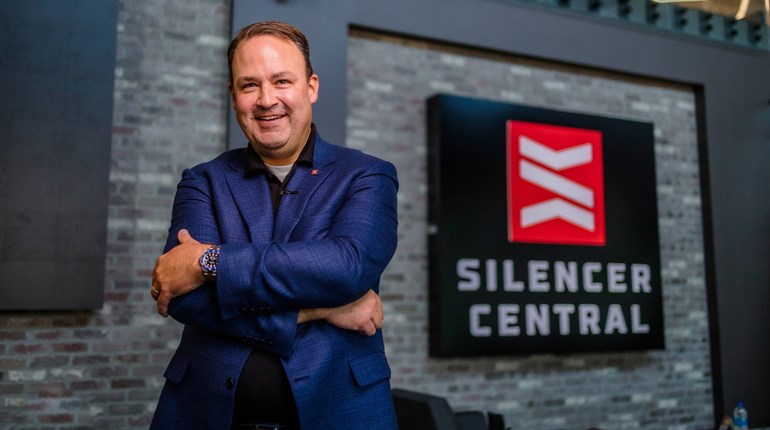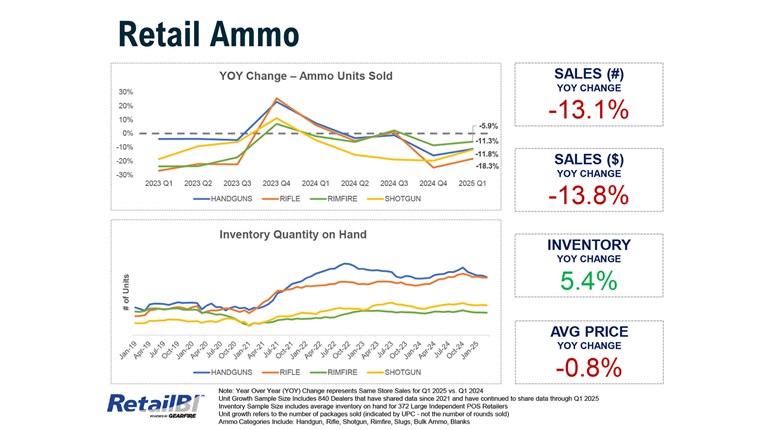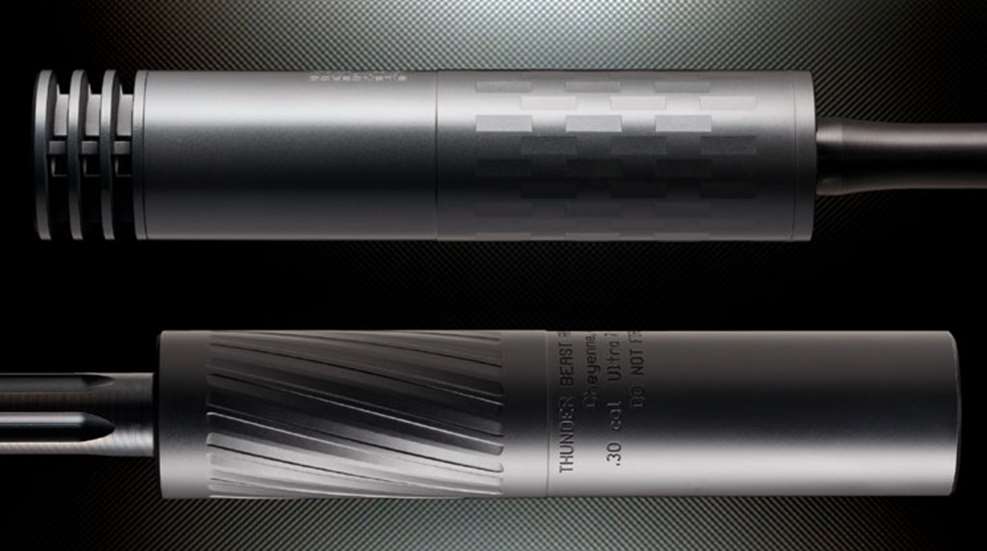
It is high time for sound suppressors to take their place among optics, slings, lights and bipods on the list of accessories commonly associated with rifles and carbines. Whether referred to as silencers, cans or suppressors, the popularity of these noise- and flash-reducing devices has skyrocketed in recent years, and for good reasons. According to the American Suppressor Association, silencers are legal to hunt with in all but four of the 42 states where they are legal to possess. That is great news for anyone seeking to save their ears and maintain good relations with their neighbors—without scaring away every animal within a half-mile radius. But that is only one small piece of the pie.
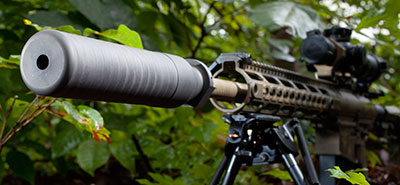
Gun owners are increasingly incorporating sound suppression into home-defense guns, too. Maintaining your ability to identify threats and having overall situational awareness are critical elements to surviving a gunfight. Firing a centerfire arm indoors, in the dark and without hearing protection can overload the senses, even when you’re ready for it. Suppressors—although adding to a firearm’s length and weight—drastically reduce muzzle flash and blast down to tolerable levels. Sound suppressors are also increasingly being used in tactical competitions, and even for plinking as shooters realize the kinetic and safety benefits these tools bring to the table.
Sound suppressor manufacturers no longer cater only to military and law enforcement customers. They are increasingly in tune with the needs of armed citizens as the roster of manufacturers has grown exponentially over the past few years. Silencer demand has driven machinists, engineers and even tinkerers to add their own unique designs into the mixed bag of suppressor offerings. You have to pay attention to keep up with changes in material, internal design, attachment methods and even specialized coatings. I thought a snapshot look at some current suppressors might be a good idea right about now.
Although BATFE uses the “silencer” moniker in its regulatory jargon, sound suppressors are anything but silent. The level of noise reduction provided is dependent on many factors, including size, design, materials, atmospheric conditions, firearm type and ammunition used. Subsonic ammunition—which leaves the muzzle moving slower than the speed of sound—is the quietest thing you can feed a suppressed firearm, since no supersonic “crack” is heard as bullets move through the air. Some suppressor designs give a slight boost to velocity, while others bleed a small amount off. The only way to be sure is to shoot your rifle, ammo and suppressor over a chronograph or at multiple distances to determine true drop and velocity. Point-of-impact (POI) shift between unsuppressed and suppressed modes can range from negligible to unmanageable, the latter being especially true with older suppressor designs. So long as POI shift is limited to a couple of inches and is consistent from one mounting to another, it is not hard to account for. Fortunately, most new sound suppressor designs are pretty decent at managing this concern.
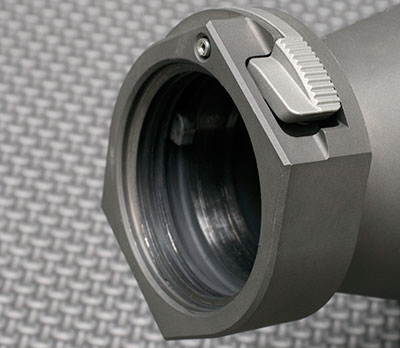
Attachment methods vary according to manufacturer and model. Detachable rifle suppressors fall into one of three categories. Traditional direct-thread cans are screwed onto threaded muzzles and usually left in place. Quick-detach (QD) mounting systems are most popular in the tactical arena because they allow for rapid installation and removal over bare muzzles, muzzle brakes or flash hiders. The third category is a takeoff of direct-thread, where the suppressor screws onto the outside of a muzzle device. Each method has its pros and cons. Although my own shooting is no more dynamic than hunting from a blind or blasting away on a range, old Army habits compel me to use QD mounts for my suppressed needs.
The Shake Out
Once I had my hands on eight loaner cans (representing four companies), I headed to the range for some comparison testing with rifles, ammo and the tools needed to change muzzle devices. I used a simple test to capture data on each silencer under the same conditions. The rifles used were a 5.56 NATO AR with an adjustable gas block and a 1-4X optic and a fixed-gas, .308 Win.-chambered AR topped by a 1-8X scope. I fed them ammunition that shoots inside of 1 MOA through these rifles: Black Hills 55-grain FMJ load in 5.56 NATO and Wolf 145-grain steel-cased ammo in .308 Win. The key performance parameters I focused on were things that concern most casual suppressor users—ease and security of attachment, POI shift between unsuppressed and suppressed modes, accuracy or velocity changes and, of course, function. We can dispense with that last factor since I had no rifle malfunctions during testing.
All shooting was from the bench at 100 yards in 82- to 85-degree weather. While my position was shaded, heat dissipation played more of a factor with some suppressors than others. To help get a better sense of how each suppressor affected accuracy, I calculated the percentage of change from unsuppressed to suppressed groups, either as a “+” for groups that got bigger or a “-” for groups that shrunk when suppressed. Test protocol was to simply shoot four, five-round groups through each suppressor, alternating between unsuppressed and suppressed for each group to check repeatability of POI shift. I also fired 10-round strings in unsuppressed and suppressed modes after grouping in order to compare muzzle velocities over an Oehler Model 35P chronograph. Over the years, I have noticed that different muzzle brakes and flash hiders can affect velocity, so each mounting system got its own unsuppressed velocity check as well.
Most of the manufacturers referenced here offer multiple options in these and similar suppressor models. It pays to check their websites when shopping to determine which configuration will work best for you before starting the NFA transfer process. Thankfully, more gun shops are picking up Class III Special Occupational Tax (SOT) licenses these days, so seeing different silencers up close is becoming easier all the time.
You may have noticed that I did not evaluate sound reductions in this comparison. One reason is I do not have a sound meter to test Sound Pressure Level (SPL). Good labs have them, and most manufacturers test their own products and provide ratings. But these numbers—usually expressed as decibel (dB) reductions—are often apple-to-orange comparisons, since different test methodologies and equipment are used from lab to lab. View them with as much accuracy as you would muzzle-velocity numbers printed on an ammo box.
The other reason I do not try to quantify sound reduction is, thanks to the handiwork of an unlucky enemy RPG gunner, my hearing is nearly gone. They all sound quiet to me. Or maybe they are loud—I cannot tell.
I learned a few things through the course of this comparison effort. Most significant is the fact that sound suppressors are a lot more user-friendly now than they were when I was still playing Army. Methods of attachment, weight reduction and POI shifting are all leaps and bounds ahead of where we were less than a decade ago. I would take any one of the suppressors covered here over those I was issued for both my CQB and sniper rifles. That is testament to the efforts of smart silencer makers who are constantly moving the bar higher and higher in order to stay ahead of the competition.
I was also reminded that it is hard to keep a direct-thread suppressor tight by hand only. If a sound suppressor has wrench flats, use them. If not, use a strap wrench unless you plan to remove it after just a few shots. In all cases—whether QD or direct thread—check tightness of the suppressor or its QD latches periodically, and remember they get very, very hot.
Lastly, I discovered that over time, sound suppressors have become integral to my rifle shooting. I have become so accustomed to the enhancements suppressors provide to my guns’ performance that I feel naked when shooting without one.
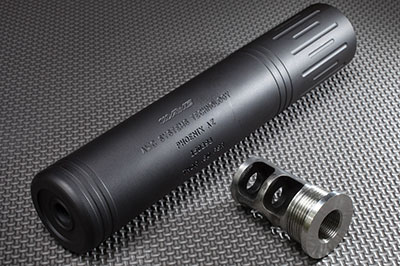
AWC Silencers Thor PSR
The Thor PSR came with a rather large, bright stainless steel muzzle brake the suppressor threaded over. It was the heaviest silencer tested, and for some reason came in a full 3 ounces heavier than its advertised weight. The Thor PSR showed minor losses in accuracy and velocity and a very manageable and consistent POI shift. The heavier design made better use of titanium than some of the lighter models, resulting in extremely good heat dissipation.

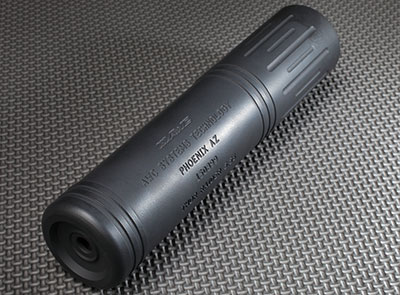
AWC Silencers Thor Raider
The Thor Raider’s 360-degree welded-titanium baffles are not rated for full-auto fire or barrels shorter than 14.5 inches. This suppressor gave me the most significant bump in accuracy, with group sizes shrinking significantly when it was attached. While that impressive feat was accompanied by a similarly significant shift in both windage and elevation, the Raider’s direct-thread-mounting system is not really intended to be an off-and-on affair. Instead, it is ideally suited for rifles that are set up for dedicated suppressed shooting. Heat dissipation with this model was excellent.

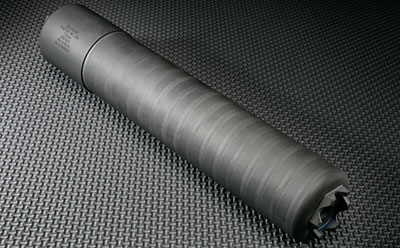
SIG Sauer SRD762Ti
The SRD762Ti is simply the direct-thread version of the SRD762Ti-QD. Missing is the QD locking area, replaced by generous wrench flats. One smart feature here is that the flats can be drilled and pinned through to permanently attach the 762-Ti to a short barrel. That way, you can bring overall barrel length to 16 inches and avoid a second NFA tax stamp. This version had more POI shift than the QD model, but again, it is designed to be left mounted, so that is really not a big deal. I did see a significant drop in accuracy between unsuppressed (threaded barrel with no flash hider or brake) and suppressed modes. With such a small sample and rudimentary test protocol, it is impossible to know whether this was an anomaly or par for this model. As with the QD suppressor, heat buildup was significant after just a few rounds were fired.

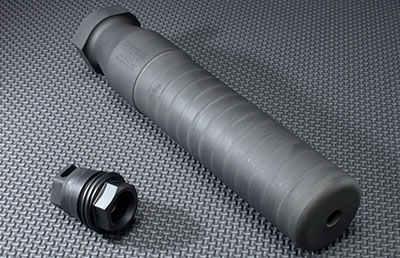
SIG Sauer SRD762Ti-QD
I am fairly certain someone at SIG Sauer had M1 Garand rifle grenades on the brain when this suppressor was on the drawing board. The SRD762Ti-QD looks as if it could send fragments and bad guys flying through the air, Hollywood-style. Fortunately, the only explosions with this suppressor are in the design department. Made of Grade-5 titanium with the ability to handle .300 Win. Mag., the SRD762Ti-QD is clearly intended for shooters whose lives depend on stealth and accuracy—but without the usual Mil-Spec price tag. An effective, pug-nosed, QD muzzle brake employs a 25-degree taper to hold the suppressor tight, with a latch serving as a secondary lock. Wrench flats on the suppressor body allow you to fully tighten against the taper. I only secured it by hand, and the SIG can stayed tight each time I fired it. Even if the shooter fails to adequately tighten the suppressor against the taper, the secondary latch will prevent further movement, ensuring safe and quiet shooting can continue. POI shift was manageable and the SRD762Ti-QD gave slight bumps in accuracy and muzzle velocity. The only real negative I noted in my range book for this suppressor was “lots of heat.” That translates to me seeing a heavy dose of heat waves in my riflescope sooner than with the other suppressors tested.

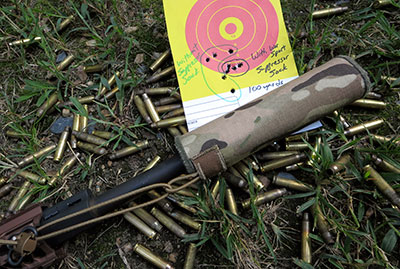
War Sport Industries Suppressor Sock
The good folks at War Sport Industries have created an effective solution for target-obscuring heat waves rising from a hot suppressor. It’s the company’s Suppressor Sock. I was lucky enough to get a prototype model several years ago, and I have worn it threadbare through heavy use in the years since.
The Suppressor Sock is made of a proprietary blend of high-tech fabrics and serves several functions. First, it significantly reduces those troublesome heat waves, allowing you to continue firing long after the can is too hot to touch. I have actually found that my suppressed groups shrink quite a bit when I use the Suppressor Sock because my target images are not distorted. Second, it helps reduce the light signature given off by hot sound suppressors at night. This is a significant advantage for our war fighters, since a hot can looks like a burning torch when viewed with night-vision gear. Third, these covers come in camo finishes, so you don’t have to paint your suppressor to match your gun camo. Lastly, the Suppressor Sock makes removing a hot suppressor by hand possible without screaming and leaving skin behind.
Suppressor Socks are available in different lengths and diameters to fit a variety of can sizes.
MSRP: $135; warsport-us.com
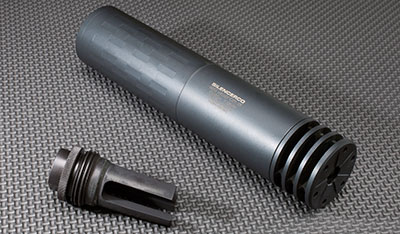
SilencerCo Omega
The Omega is light, yet strong enough to withstand the blast from barrels as short as 8 inches in 5.56 NATO and .300 Blackout or 16 inches in .308 Win. Its attachment system is fast, simple and secure. A rotating band at the rear of the body locks the Omega’s integral ASR mount over any SPECWAR Trifecta muzzle brake or flash hider. The ASR’s lock offers both visual and tactile confirmation of being secured. Unlike other suppressors that use similar thread and ratchet securing systems, you should not attempt to unscrew the Omega to check for tightness once the locking band has been rotated into position. Doing so will allow the suppressor mount’s ratchet to slip over the muzzle device’s teeth, stripping it. SilencerCo states that the design will not come loose, even when used on belt-fed machine guns. The ratchet lock is simply a secondary means to keeping the can tight. The Omega also comes with a direct-thread mount, so the owner has the option to screw it directly to the barrel or use an ASR mount in QD fashion. SilencerCo advertises the Omega as the shortest .30-caliber suppressor (in direct-thread configuration) and the quietest when used with the ASR mount.

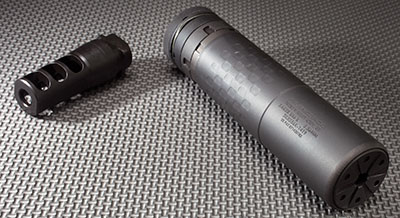
SilencerCo Saker K 556
The Saker is probably the most versatile suppressor I have ever seen. It is also fairly confusing when it comes to sorting out the mounting options. Each Saker comes with a MAAD mount that threads into the back of the suppressor body and is unique to different muzzle treatments. MAAD mounts that function as QDs with SilencerCo’s Saker Trifecta muzzle brake or flash hider (tested), the company’s ASR/SPECWAR mounts, mounts for Advanced Armament Company’s popular 51T mounts or Yankee Hill Machine’s Y QD mounts are all available. A direct-thread MAAD is also an option.
I had some trouble with the first unit I tested. It was difficult to lock onto the Saker Trifecta flash hider, and once it did lock, something broke internally, turning it into a permanent mount. A SilencerCo rep was on hand to provide a replacement MAAD mount and a new flash hider, after which no further problems were encountered. The lack of a protruding latch and the small outer diameter of the Saker make it ideal for use beneath many freefloat handguards. The Saker’s stellite baffles are advertised as being 30-percent stronger than similar, high-tech alloys, allowing this suppressor to be used on barrels as short as 7 inches in 5.56 NATO and in full-automatic mode. POI shift was minimal, but group-size increase was somewhat pronounced.

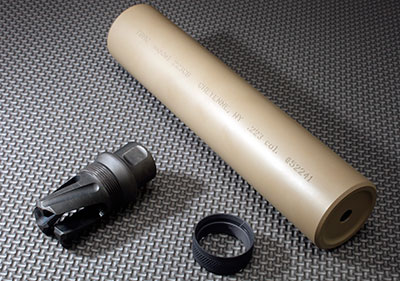
Thunder Beast Arms .223 CB
The .223 CB mounts via threads on Thunder Beast’s new, compact muzzle brake. Like many smaller suppressors, it is not rated for full-automatic fire or barrels shorter than 14.5 inches. Though constructed of lightweight titanium, heat in the scope’s field-of-view did not become a problem until approximately 10 rounds had been fired at a rate of about one round every 10 seconds. Thunder Beast makes good use of a conical shoulder bearing surface to keep POI shift to a minimum. I was not crazy about thread-over-muzzle device mounts prior to using this suppressor, but its virtual lack of changes to velocity, accuracy and POI shift made this mounting system very attractive.

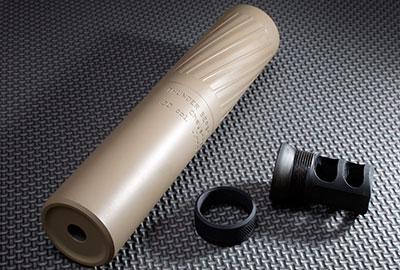 Thunder Beast Arms Ultra 7 CB
Thunder Beast Arms Ultra 7 CB
Unlike its small-caliber brother, the Ultra 7 CB had a fair bit of POI shift in spite of the same conical-shouldered muzzle brake design. Fortunately, all shift was vertical and consistent between on and off cycles. This titanium .30-caliber can is rated up to .300 RUM in a 20-inch barrel and can handle .300 Win. Mag. in 18-inch or .308 Win. in 14.5-inch pipes. The Ultra 7 is also available as a direct-thread mount in a variety of thread pitches. I found that after five rounds, the heat coming off this model was enough to make precise aiming difficult. But given this was the lightest suppressor I tested—coming in at less than half the weight of the heaviest model—the amount of heat visible in my scope was understandable.














